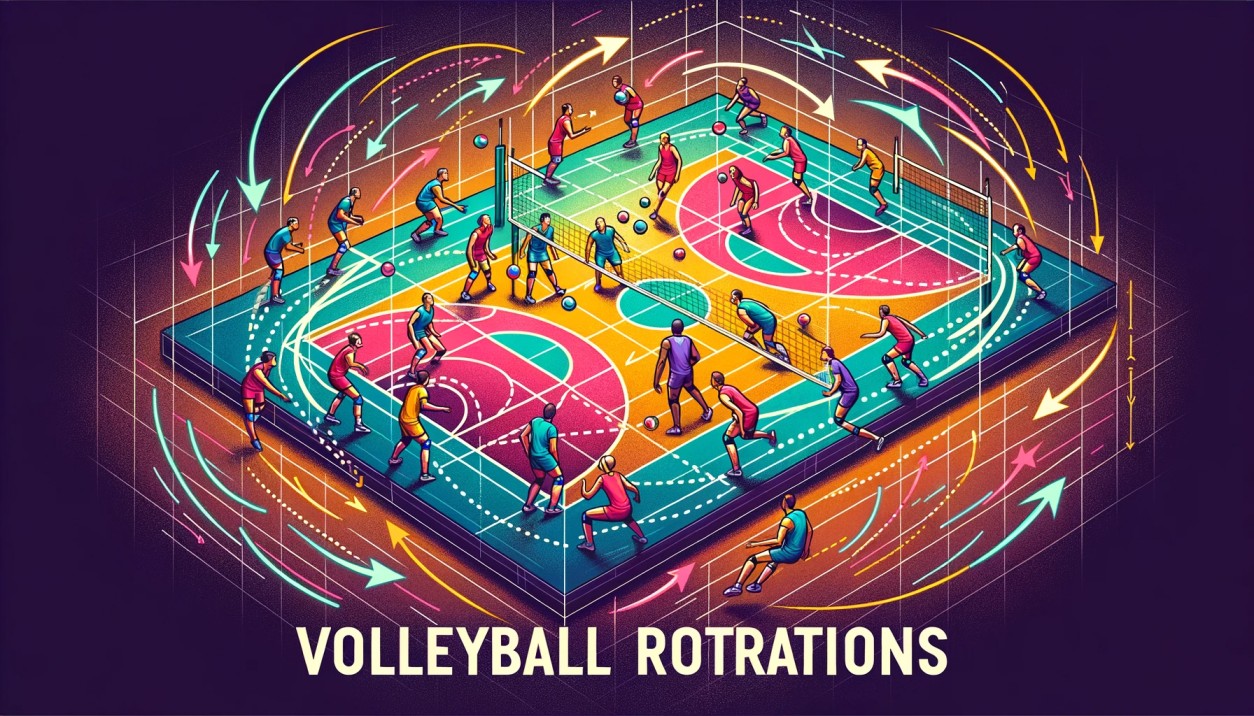Volleyball Rotations: Complete Guide
Introduction
In this article, complete information about Volleyball Rotations is given. Understanding volleyball rotations is crucial for anyone who’s serious about the game, whether you’re a player, a coach, or a die-hard fan. This guide will delve into the nitty-gritty of rotations, why they’re so important, and how to master them. So, buckle up; you’re in for a spin.
What Are Volleyball Rotations?
In its simplest form, a rotation in volleyball is when players move positions in a clockwise direction after winning back the serve. This isn’t just a game of musical chairs; it’s a strategic move that can make or break a match.

Why Are Rotations Important?
- Team Strategy: Knowing when and how to rotate allows for optimal player positioning, making it easier to attack and defend.
- Legal Requirements: Rotations aren’t just a strategy; they’re a rule. Incorrect rotations can lead to penalties.
- Impact on Performance: Mastering rotations can significantly improve a team’s performance, affecting both individual and collective stats.
The Six Positions in Volleyball
In volleyball, there are six main positions, each with its unique role and importance in rotations:
- Setter: The playmaker who sets up the ball for attacks.
- Outside Hitter: Specializes in attacking balls from the front left side of the court.
- Middle Blocker: The defensive wall and quick attacker in the front row.
- Opposite: Positioned opposite the setter, responsible for blocking and attacking.
- Libero: The defensive specialist who can replace any back-row player.
- Defensive Specialist: Similar to a libero but without the same substitution rules.
Understanding the roles of each of these positions is key to mastering rotations.

The Basic Rules of Volleyball Rotations
Volleyball Rules Of Rotation
Understanding the rules of rotation in volleyball is crucial for both players and coaches. The rotation ensures that each player gets an opportunity to play at the front and back of the court. Here are some key rules to remember:
4 Volleyball Overlap Rule
- Players must be in their correct serving order at the time the ball is served.
- Players can’t overlap with adjacent players in front or behind them.
4 The Overlap Rule Applies To The Serving Team Too
- The serving team must also adhere to the overlap rule.
- Players must be in their correct positions until the ball has been served.
4 After Serving, The Defending Team’s Players Move To Their Base Positions
- Once the ball is in play, players can move to their base positions.
- The defending team can then adjust their formation to better defend against the attack.
4 Player Positions Must Mirror Each Other
- Players on opposite sides of the net must mirror each other’s positions.
- This rule ensures fairness and balance in the game.
4 The Libero Can Rotate In & Out At Will
- The Libero is a specialized defensive player who can rotate in and out freely.
- However, they must adhere to certain substitution rules to maintain the integrity of the game.
- Clockwise Movement: Players must rotate in a clockwise direction when their team wins back the serve.
- Positional Requirements: Players must be in their correct rotational order when the ball is served.
- Penalties for Wrong Rotations: Incorrect rotations can lead to loss of points and serve.
Different Volleyball Rotations
Understanding different types of rotations can give teams an advantage. Here are some common rotations:
3 4-2 Volleyball Rotation
- 4 front-row players and 2 back-row players.
- Simple and easy to implement, but less offensive power.
3 6-2 Volleyball Rotation
- 6 players can act as hitters at different times.
- More complex but offers greater offensive options.
3 5-1 Volleyball Rotation
- One setter who stays in the game for all six rotations.
- Requires a highly skilled setter but offers a lot of flexibility.
3 5-2 Volleyball Rotation
- Similar to 5-1 but with two setters.
- Allows for more specialized roles but can be difficult to coordinate.
Advanced Volleyball Rotations Strategies
Understanding advanced strategies can give your team a competitive edge. Here are some tactics to consider:
- Stacking: This involves aligning multiple players in one area of the court to disguise your intended play. It’s like a volleyball version of a magic trick!
- Front-row and Back-row Strategies: In the front row, you might focus on quick sets and powerful spikes. In the back row, the emphasis could be on serves and digs.
- Specialized Rotations: These are custom rotations designed to maximize the strengths of your team’s unique skill set. For example, keeping your best spiker always in the front row.
Common Mistakes in Volleyball Rotations
Even seasoned players can mess up rotations. Here are some common mistakes:
- Over-rotation: Moving too far or too quickly, causing confusion or penalties.
- Under-rotation: Not moving enough or moving too slowly, also leading to penalties.
- Miscommunication: This is the big one. If team members aren’t clear about when and how to rotate, chaos ensues.
How to Practice Volleyball Rotations
Mastering rotations takes practice. Here’s how to get started:
- Drills: Use targeted drills to practice specific rotation scenarios. For example, “out-of-system” drills can help you prepare for unexpected situations.
- Team Exercises: Full-team practices can help everyone understand their roles within rotations better.
- Tips for Individual Practice: Even when practicing alone, you can improve your understanding of rotations by studying game footage or using visualization techniques.
FAQs
· What happens if you rotate incorrectly in volleyball?
Incorrect rotations usually result in a point and serve going to the opposing team.
· How do you know when to rotate in volleyball?
You rotate when your team wins back the serve.
· Can the libero serve in volleyball?
In some leagues and levels, yes, the libero can serve, but they are often restricted to a specific rotation position.
· What is a double sub in volleyball?
A double sub is when two players are substituted at the same time, often to improve both the front-row and back-row capabilities.
· How many rotations are in volleyball?
- In volleyball, there are six basic rotations. These rotations correspond to the six positions on the court. Each time a team wins back the serve, they rotate one position clockwise.
· What are rotations in volleyball?
- Rotations in volleyball refer to the movement of players around the court in a specific pattern, usually clockwise. Rotations are essential for maintaining a balanced team formation and are a critical part of the game’s strategy and rules.
· Why is it called 6-2 volleyball rotation?
- The term “6-2” in volleyball rotation refers to a strategy involving 6 hitters and 2 setters. When the setter rotates to the back row, a second setter comes in, allowing for a constant three-hitter front row, thereby maximizing offensive capabilities.
· What is rotation 4 in volleyball?
- Rotation 4 in volleyball typically involves the setter being in the front-right position, with the outside hitter in the front-left and the middle blocker in the front-center. This rotation is crucial for setting up plays and is often considered an offensive formation.
· What is the rule for rotation?
- The basic rule for rotation in volleyball is that players must rotate clockwise whenever their team wins back the serve. Players must also be in their correct rotational order when the ball is served, or else they risk penalties like loss of points or serve.
- What is a 5-2 rotation in volleyball?
- A 5-2 rotation in volleyball involves 5 hitters and 2 setters. Unlike the 6-2 rotation, one of the hitters may also act as a setter, making it a bit more flexible but less specialized than the 6-2.
· What is 5-1 and 6-2 in volleyball?
- In a 5-1 rotation, there is one setter and five hitters. The setter sets for all six rotations. In a 6-2 rotation, there are two setters and six hitters, allowing for a three-hitter front row at all times.
· What is rotation 3 in volleyball?
- In rotation 3, the setter is usually in the back-right position, with the outside hitter in the back-left and the opposite in the back-center. This rotation is often considered a defensive formation.
· What is a 5-1 rotation?
- A 5-1 rotation in volleyball involves one setter who sets for all six rotations and five hitters. This formation is simpler than the 6-2 but requires a very skilled setter.
· What does rotation 1 mean in volleyball?
- Rotation 1 in volleyball typically starts with the setter in the back-row, specifically in the right-back position. The outside hitter is usually in the left-back position, and the opposite is in the middle-back.
· How does a libero rotate?
- The libero is a defensive specialist and does not follow the standard rotation rules. They can replace any back-row player without counting as a substitution but cannot serve in most leagues (though some allow it for a specific rotation).
· What does 2 and 4 mean in volleyball?
- The numbers 2 and 4 usually refer to the positions on the court in volleyball. Position 2 is the front-right position, often occupied by the setter in many rotations. Position 4 is the front-left position, usually occupied by an outside hitter.
· High School Volleyball Rotations: Best Options?
- For high school teams, simpler rotations like 4-2 are often recommended.
- However, more advanced teams may opt for 6-2 or 5-1 for greater offensive capabilities.
· How To Memorize Volleyball Rotations?
- Use visual aids like charts or diagrams.
- Practice the rotations repeatedly during training.
- Coaches can use specific drills to help players internalize the rotations
Conclusion
Understanding and mastering volleyball rotations can significantly elevate your game. It’s not just about moving in a circle; it’s about strategic positioning, teamwork, and making the most of each player’s skills. So get out there, practice, and turn your newfound knowledge into on-court success!





